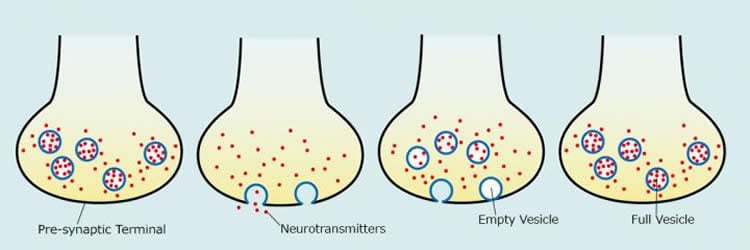Summary: A new study sheds light on the process of vesicle recycling.
Source: OIST.
Neurons in the brain form tangled webs of connections. Within these webs, cells communicate with each other to control motor, cognitive and other functions.
A neuron, when activated, propagates an electrical signal. But that signal cannot cross the synapse — the junction between two neurons. So, communication from one neuron to the next is accomplished by the release of tiny membrane capsules containing signaling chemicals called neurotransmitters across the synapse.
The electrical signal triggers these capsules, called vesicles, to fuse with membrane at the neuron’s pre-synaptic terminal, thereby releasing neurotransmitters into the cleft between the two cells. The neurotransmitters travel across the cleft, then activate receptors in the post-synaptic neuron, triggering an electrical signal in that next cell.
Because the neurotransmitter signal goes in one direction — from the pre-synaptic neuron to the post-synaptic one — vesicles must be re-formed for the process to continue. “Recycling is a critical process to keep synapses functional,” explains Professor Takahashi, leader of the Cellular & Molecular Synaptic Function Unit at the Okinawa Institute of Science and Technology Graduate University (OIST). In a study recently published in Cell Reports, Takahashi and his colleagues shed light on a poorly-understood part of vesicle recycling.
Vesicle recycling involves three steps: First, lipid membrane must be pinched off from the neuron’s membrane to form vesicles, a process called endocytosis. Then, the vesicles must be refilled with neurotransmitter. Finally, filled vesicles must be transported to the release site. Although endocytosis has been well-studied, little was known about the refilling process. Prof. Takahashi, in collaboration with a former OIST researcher and colleagues at Doshisha University, now show that for at least one major type of synapse, refilling takes longer than endocytosis.
The findings show that the refilling step can determine the rate at which vesicles are recycled and reused at the synapse. Neuroscientists have long thought that it was endocytosis that limited the speed of recycling, says Prof. Takahashi. “However, we showed that vesicle refilling rate is also an important factor.”
Neurons can form excitatory connections or inhibitory ones, depending on which neurotransmitters they release across the synapse. The neurotransmitter glutamate passes along an excitatory signal, meaning that it boosts the chance that the electrical signal from the first cell will be passed along to the second. The neurotransmitters GABA and glycine, on the other hand, transmit an inhibitory message, telling the subsequent cell not to fire.
At excitatory synapses, Prof. Takahashi’s group has previously measured the rate at which glutamate is taken up into vesicles during recycling. However, this refilling rate had not been studied in inhibitory synapses. Prof. Takahashi and colleagues used glass electrodes to simultaneously take recordings from the pre-synaptic terminal and the post-synaptic terminal at an inhibitory synapse. They showed that, at inhibitory terminals, GABA is taken up into vesicles five to six times more slowly than glutamate at excitatory synapses.
The vesicular GABA uptake rate was estimated using a special technique called caged GABA compound UV photolysis. The researchers injected GABA that was “caged” by a synthetic compound that prevents it from refilling vesicles, into the pre-synaptic terminal. The neurotransmitter’s release from the cage is controlled by UV illumination, which provides the energy to change the synthetic compound’s 3D structure. Using a flash of UV light, the scientists could release the GABA into the pre-synaptic terminal at a specific moment and then measure the rate of uptake of GABA back into the vesicles.

Remarkably, they showed that the time taken to refill the vesicles with GABA is nearly identical to the overall time taken for a synapse to recover from synaptic depression – a neuron’s inability to fire because the vesicles carrying the message across the synapse are used up. This implies that most of the recovery time is devoted to refilling the vesicles. In contrast, reforming the vesicles takes relatively less time. Vesicle refilling is time consuming because GABA is concentrated 10-100 times inside the vesicle, compared to the rest of the cell, using molecular pumps.
Therefore, the researchers concluded that the slow rate of refilling vesicles with GABA can be a rate-limiting step for the neurotransmitter recycling process at inhibitory synapses.
Since all inhibitory neurons in the brain use either GABA or glycine, a neurotransmitter which is recycled in the same way as GABA and refilled into vesicles using the same molecular pump, this principle likely applies to all inhibitory neurons in the brain. This suggests that the vesicle refilling process is crucial to maintaining many important brain functions.
Funding: JSPS Core-to-Core Program A, Advanced Research Networks, Okinawa Institute of Science and Technology funded this study.
Source: Peter Zekert – OIST
Publisher: Organized by NeuroscienceNews.com.
Image Source: NeuroscienceNews.com image is credited to OIST.
Original Research: Open access research for “Vesicular GABA Uptake Can Be Rate Limiting for Recovery of IPSCs from Synaptic Depression” by Manami Yamashita, Shin-ya Kawaguchi, Tetsuya Hori, and Tomoyuki Takahashi in Cell Reports. Published online March 20 2018.
doi:10.1016/j.celrep.2018.02.080
[cbtabs][cbtab title=”MLA”]OIST “Recycling at the Synapse Revealed.” NeuroscienceNews. NeuroscienceNews, 26 March 2018.
<https://neurosciencenews.com/synapse-recycling-8691/>.[/cbtab][cbtab title=”APA”]OIST (2018, March 26). Recycling at the Synapse Revealed. NeuroscienceNews. Retrieved March 26, 2018 from https://neurosciencenews.com/synapse-recycling-8691/[/cbtab][cbtab title=”Chicago”]OIST “Recycling at the Synapse Revealed.” https://neurosciencenews.com/synapse-recycling-8691/ (accessed March 26, 2018).[/cbtab][/cbtabs]
Vesicular GABA Uptake Can Be Rate Limiting for Recovery of IPSCs from Synaptic Depression
Highlights
•Vesicular GABA uptake time constant is 40 s at physiological temperature
•Recovery rate of IPSCs from depression coincides with vesicular GABA uptake rate
•Vesicular GABA uptake can be rate limiting for recovery of IPSCs from depression
Summary
Synaptic efficacy plays crucial roles in neuronal circuit operation and synaptic plasticity. Presynaptic determinants of synaptic efficacy are neurotransmitter content in synaptic vesicles and the number of vesicles undergoing exocytosis at a time. Bursts of presynaptic firings depress synaptic efficacy, mainly due to depletion of releasable vesicles, whereas recovery from strong depression is initiated by endocytic vesicle retrieval followed by refilling of vesicles with neurotransmitter. We washed out presynaptic cytosolic GABA to induce a rundown of IPSCs at cerebellar inhibitory cell pairs in slices from rats and then allowed fast recovery by elevating GABA concentration using photo-uncaging. The time course of this recovery coincided with that of IPSCs from activity-dependent depression induced by a train of high-frequency stimulation. We conclude that vesicular GABA uptake can be a limiting step for the recovery of inhibitory neurotransmission from synaptic depression.






